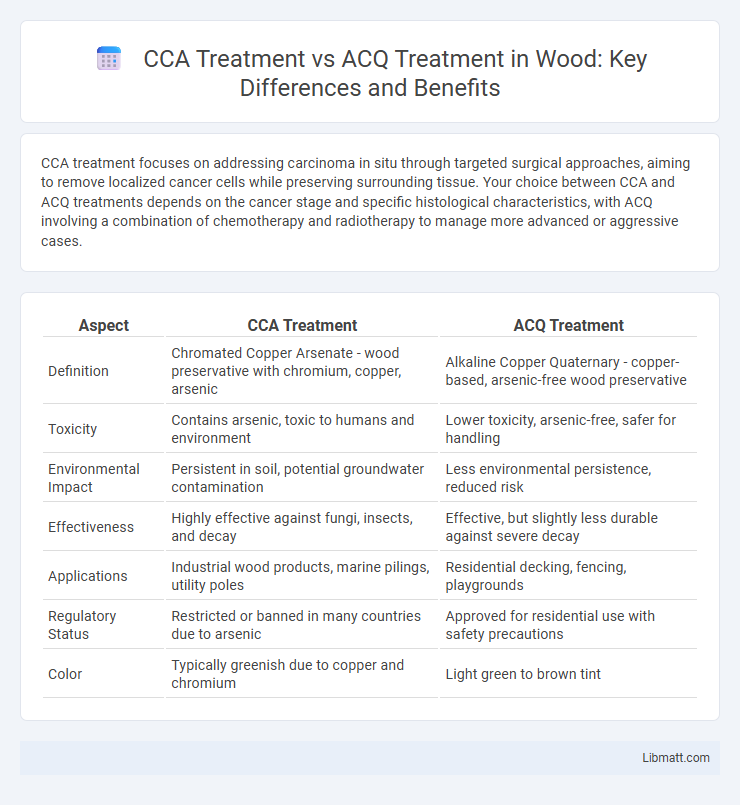CCA treatment focuses on addressing carcinoma in situ through targeted surgical approaches, aiming to remove localized cancer cells while preserving surrounding tissue. Your choice between CCA and ACQ treatments depends on the cancer stage and specific histological characteristics, with ACQ involving a combination of chemotherapy and radiotherapy to manage more advanced or aggressive cases.
Table of Comparison
| Aspect | CCA Treatment | ACQ Treatment |
|---|---|---|
| Definition | Chromated Copper Arsenate - wood preservative with chromium, copper, arsenic | Alkaline Copper Quaternary - copper-based, arsenic-free wood preservative |
| Toxicity | Contains arsenic, toxic to humans and environment | Lower toxicity, arsenic-free, safer for handling |
| Environmental Impact | Persistent in soil, potential groundwater contamination | Less environmental persistence, reduced risk |
| Effectiveness | Highly effective against fungi, insects, and decay | Effective, but slightly less durable against severe decay |
| Applications | Industrial wood products, marine pilings, utility poles | Residential decking, fencing, playgrounds |
| Regulatory Status | Restricted or banned in many countries due to arsenic | Approved for residential use with safety precautions |
| Color | Typically greenish due to copper and chromium | Light green to brown tint |
Understanding CCA and ACQ Wood Treatments
CCA (Chromated Copper Arsenate) treatment penetrates wood to provide long-lasting protection against decay, fungi, and insects by embedding toxic compounds deep within the fibers. ACQ (Alkaline Copper Quaternary) treatment uses a copper-based biocide combined with a quaternary ammonium compound to offer effective, environmentally friendlier protection without arsenic or chromium. Your choice depends on the intended use, environmental regulations, and the desired balance between durability and ecological impact.
Chemical Composition: CCA vs ACQ
CCA treatment contains chromium, copper, and arsenic, which provide strong protection against decay, insects, and fungal growth. ACQ treatment uses alkaline copper quaternary compounds combined with ammonium, avoiding arsenic and chromium for a more environmentally friendly alternative. The chemical composition differences result in CCA being highly effective but more toxic, while ACQ offers safer handling and disposal with slightly higher corrosion potential on fasteners.
Environmental Impact of CCA and ACQ
Chromated Copper Arsenate (CCA) treatment poses significant environmental risks due to its arsenic content, which can leach into soil and groundwater, causing toxicity to plants and wildlife. In contrast, Alkaline Copper Quaternary (ACQ) treatment, free of arsenic and chromium, is considered more environmentally friendly, although it still releases copper compounds that may affect aquatic ecosystems. The shift from CCA to ACQ reflects increased regulatory restrictions and a growing preference for safer, less hazardous wood preservation methods.
Health and Safety Considerations
CCA treatment uses chromated copper arsenate, which contains toxic compounds posing risks of arsenic and chromium exposure, leading to potential health hazards such as respiratory issues and skin irritation. ACQ treatment, comprising alkaline copper quaternary compounds, offers a safer alternative with lower toxicity and reduced environmental impact, minimizing health risks to workers and end-users. Proper protective equipment and handling procedures remain critical for both treatments to ensure health and safety compliance.
Effectiveness Against Decay and Insects
CCA treatment offers superior protection against wood decay and insect damage due to its deep penetration and broad-spectrum biocidal properties. ACQ treatment provides effective decay resistance as well but tends to be less effective against certain wood-boring insects compared to CCA. Both treatments are widely used for preserving wood, yet CCA remains the preferred choice in environments with high risk of decay and insect infestation.
Application Methods for CCA and ACQ
CCA treatment involves brush, spray, or dip methods primarily for wood preservation against fungi and insects, ensuring deep penetration into timber. ACQ treatment utilizes vacuum-pressure impregnation to force the copper-based preservative deep into wood fibers, providing corrosion resistance and durability. Both application methods cater to enhancing wood longevity but differ in chemical composition and environmental impact.
Longevity and Durability Comparison
CCA treatment exhibits superior longevity and durability compared to ACQ treatment due to its robust corrosion resistance and longer-lasting protective film. Studies reveal that CCA-treated materials maintain structural integrity for 15-20 years, whereas ACQ-treated counterparts typically endure 10-15 years before significant degradation occurs. This enhanced lifespan makes CCA treatment preferable for applications requiring extended durability under harsh environmental conditions.
Cost Analysis: CCA vs ACQ
Cost analysis between CCA (Composite Core Alloys) and ACQ (Alkaline Copper Quaternary) treatments reveals significant differences in material and application expenses. CCA treatment generally incurs higher upfront costs due to advanced composite materials but offers longer-lasting protection against decay and corrosion. Your choice depends on balancing initial investment with long-term maintenance savings, as ACQ tends to require more frequent retreatment, increasing overall lifecycle costs.
Regulatory Status and Restrictions
CCA treatment is approved by the FDA for specific cancer indications, with strict regulatory guidelines governing its administration and patient eligibility criteria. In contrast, ACQ treatment remains under investigational review in several regions, limiting its widespread clinical use and subjecting it to ongoing clinical trial protocols. Regulatory agencies impose varying restrictions on ACQ due to insufficient long-term safety data compared to the extensively studied CCA regimen.
Choosing the Right Treatment for Your Project
Choosing between CCA treatment and ACQ treatment depends on the project's environmental exposure and wood preservation needs. CCA (Chromated Copper Arsenate) offers superior resistance to decay and insect damage, making it ideal for outdoor applications with high moisture. ACQ (Alkaline Copper Quaternary) provides a less toxic alternative while ensuring strong protection, suitable for residential decks and playgrounds where chemical sensitivity is a concern.
CCA treatment vs ACQ treatment Infographic

 libmatt.com
libmatt.com